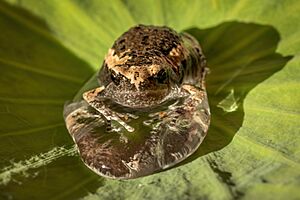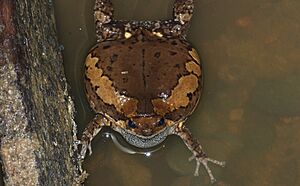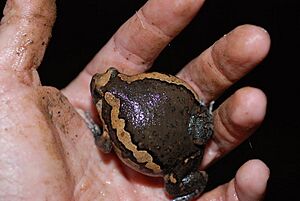Banded bullfrog facts for kids
Quick facts for kids Banded bullfrog |
|
|---|---|
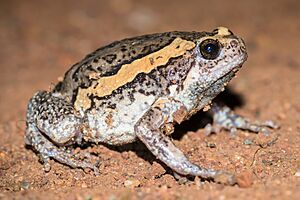 |
|
| Conservation status | |
| Scientific classification | |
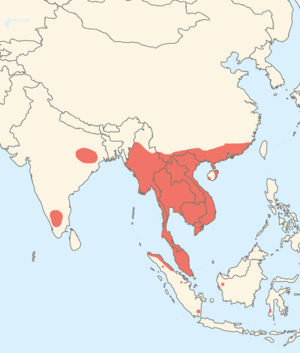 |
|
| Banded bullfrog range |
The banded bullfrog (Kaloula pulchra) is a type of frog. It belongs to a group of frogs called "narrow-mouthed frogs." These frogs are originally from Southeast Asia. You might also hear them called the Asian painted frog, digging frog, or chubby frog (especially if they are pets).
Adult banded bullfrogs are about 5.4 to 7.5 centimeters (2.1 to 3 inches) long. They have a dark brown back with stripes that can be copper-brown or salmon pink. These frogs live in many places, like cities, farms, and forests. They can even bury themselves underground when it's dry. They come out to find food and breed after it rains a lot.
Banded bullfrogs mostly eat ants and termites. But they can be eaten by snakes, dragonfly larvae, and snails. If they feel scared, they can puff up their bodies. They also let out a white, sticky substance that tastes bad to predators. Sometimes, these frogs are sold as pets. They can become an invasive species in new places like Taiwan and the Philippines.
Contents
What's in a Name?
The banded bullfrog was first described in 1831 by a British zoologist named John Edward Gray. He gave it the scientific name Kaloula pulchra. The word pulchra means "beautiful" in Latin.
Over time, this frog has been called many different names. Some of these include the Malaysian narrowmouth toad, Asian painted frog, and painted balloon frog. In the pet world, it's often called the chubby frog.
How to Spot a Banded Bullfrog
Banded bullfrogs are medium-sized frogs. They have a sturdy, triangle-shaped body and a short nose. Male frogs are usually 5.4 to 7.0 cm (2.1 to 2.8 in) long. Females are a little bigger, reaching 5.7 to 7.5 cm (2.2 to 3.0 in) long. They weigh about 80 to 120 grams (2.8 to 4.2 oz).
Their backs are dark brown with stripes that can be copper-brown or salmon pink. Their bellies are a creamy white color.
Baby Frogs (Tadpoles)
When they first hatch, tadpoles are tiny, about 0.5 cm (0.2 in) long. They grow to about 1.1 cm (0.4 in) by the time they become frogs. Tadpoles have an oval body that is brown or black with a light belly. Their eyes are small, with dark centers and a golden ring.
As they change into frogs, their eyes get bigger and stick out more. They also grow thin legs and toes. This change, called metamorphosis, can start as early as two weeks after hatching.
Where They Live
The banded bullfrog is native to Southeast Asia. You can find them in places like northeastern India, Nepal, southern China, and Myanmar. They also live on islands in maritime Southeast Asia. They can live in many different places, from sea level up to about 750 meters (2,460 ft) high. This includes cities, rural areas, and forests.
When They Become Invaders
The banded bullfrog can sometimes become an invasive species. This means they spread to new places where they don't naturally belong. They can get there through the pet trade or by hitching rides on ships. They have already settled in places like Taiwan, the Philippines, and Guam.
Some frogs have been seen in Australia and New Zealand. In Florida, a few were found in 2006 and 2008. However, efforts were made to control them, and they haven't reproduced there.
How They Live
Banded bullfrogs start to breed after heavy monsoon rains. They come out from underground and go to rain pools or ponds. Even during dry times, their bodies are ready to mate as soon as the rain starts. In India, males start calling after the monsoon season begins in April or May.
These frogs are better at walking and burrowing than jumping. They can survive dry weather by digging into the ground. They use their back legs to dig down several inches. They can stay there until the dry season ends. During the day, they hide under leaves. At night, they come out to eat. They have even been seen hunting termites in trees!
What They Eat and Who Eats Them
In the wild, banded bullfrogs mainly eat ants and termites. They also eat other small bugs like flies, crickets, and earthworms. Their small heads and mouths mean they mostly eat small, slow-moving prey.
Snakes, like the kukri snake, eat adult banded bullfrogs. For their eggs and tadpoles, predators include dragonfly larvae and snails.
When a banded bullfrog feels threatened, it puffs up its body to look bigger. This can scare away predators. They also release a white, bad-tasting substance from their skin. This substance is not harmful, but it makes predators not want to eat them.
Banded Bullfrogs as Pets
Banded bullfrogs are often sold in pet stores. They do well in terrariums with soil or moss. While wild frogs eat ants and termites, pet frogs usually eat insects like crickets or mealworms.
A study found that many banded bullfrogs are offered for sale as pets. Most of these frogs are caught from the wild, not bred in captivity. In the Philippines, people catch these frogs locally to sell them. Some people think these frogs have been sold illegally in South America for many years.
Protecting Banded Bullfrogs
The International Union for Conservation of Nature says the banded bullfrog is a species of "least concern." This means they are not currently in danger of disappearing. They live in many places, can adapt to different environments, and have a large population. Even though people catch them for food in some areas, it doesn't seem to harm their overall numbers.



